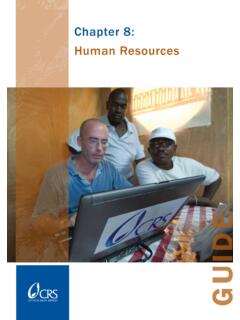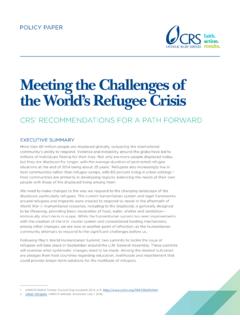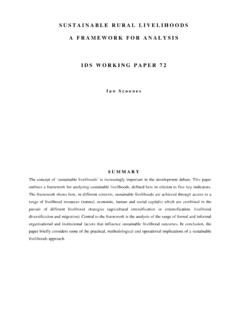Transcription of Emergency Preparedness and Response Handbook - CRS
1 EmergencyPreparedness & ResponseHandbookAcknowledgementsPublishe d by Catholic Relief Services, November Quality and Support DepartmentCatholic Relief Services209 W. Fayette , MD guidelines are a product of the CRS Emergency Response Team (ERT), a unit of theProgram Quality and Support Department (PQSD). Annemarie Reilly is the primary Aker contributed to the section on conceptual frameworks and food security. Much ofthe information related to disaster prevention, mitigation and Preparedness is borroweddirectly or adapted from the CRS Mitigation Handbook (Kristen Hicks, 1996). Theinformation regarding contingency planning is adapted from the United Nations Contingency Planning: A Practical Guide for Field Staff (Complex Emergencies TrainingInitiative-CETI, 1996).
2 PQSD and ERT members contributed to the content and reviewed all drafts. Drafts were alsopeer reviewed by CRS staff representing both headquarters and field offices. A specialthanks to all who contributed to this Bureau of Population, Refugees and MigrationCICaritas InternationalisCRCountry RepresentativeCREDC entre for Research on the Epidemiology of DisastersDFIDUK Department for International DevelopmentDOSUS Department of StateECHOE uropean Community Humanitarian OfficeEMTE xecutive Management TeamERTE mergency Response TeamERWGE mergency Response Working GroupFFP/ERUSAID Food for Peace/ Emergency ResponseHRHuman ResourcesHQHeadquarters CRS/BaltimoreICRC/IFRCI nternational Committee of the Red Cross/Red Crescent/InternationalFederation of the Red Cross/Red Crescent SocietiesIDPI nternally Displaced PersonIFADI nternational Fund for Agriculture
3 DevelopmentNGONon-governmental OrganizationOCHAUN Office of Coordination for Humanitarian AffairsOFDAUSAID Office of Foreign Disaster AssistanceOSDO verseas Support DepartmentOTIUSAID Office of Transition InitiativesRDRegional DirectorSHARPCRS Strategic Humanitarian Action PlanSFPS upplementary Feeding ProgramTAPT ransition Activities ProgramTDYT emporary DutyTFPT herapeutic Feeding ProgramUSAIDU nited States Agency for International DevelopmentUSDAU nited States Department of AgricultureUNHCR United Nations High Commissioner for RefugeesWFPW orld Food ProgrammeWHOW orld Health OrganizationTable of ContentsIntroductionSection 1: Foundations of CRS Emergency Preparedness & The CRS Emergency Preparedness & Response Mission and Emergency Preparedness & Response : Key Definitions and What is an Emergency ?
4 Disaster Emergency Understanding Disaster Prevention, Mitigation and Disaster Disaster Disaster Cross-cutting Themes in Emergency Preparedness & The Rights-based Approach to Humanitarian The CRS Justice Lens and Peacebuilding in Do No Capacity Building and Transition Principle-led ProgrammingSection 2: Emergency Preparedness & Response Program General Background on CRS Emergency Preparedness & CRS Emergency Preparedness & Response Program Quality Statements andTechnical Core Excellence in Emergency Building Blocks for CRS Emergency Program The Big Picture: The Relief-Development Conceptual Frameworks for The Project Project Goals, Objectives, Targeting and Selection Monitoring and EvaluationSection 3: CRS Emergency Projects: Funding, Review, Headquarters Funding CRS Private Caritas Internationalis US Department of US Embassy Ambassador s United Other Project Review and Funding HQ Emergency Response Working GroupAnnexesA.
5 CRS Guidelines on Humanitarian Aid in Conflict SituationsB. ICRC/IFRC/NGO Code of ConductC. Sphere Project Humanitarian CharterD. International Law Instruments and Ground Rules for Humanitarian Aid in ConflictSituationsE. CRS Emergency Preparedness & Response Program Quality StatementsF. CRS Emergency Proposal FormatG. Technical Review FormatH. Gap Identification ChartI. Caritas Internationalis (CI) Guiding Values, Principles, Working Structures andMechanisms for Response to Major EmergenciesJ. CRS Situation Reporting FormatsK. Emergency Response Team Organizational ChartL. Emergency Response Checklist for ManagersM. Websites for Humanitarian Relief News, Organizations and DonorsBoxesBox CRS Mission StatementBox CRS Vision StatementBox CRS EPR Vision and Mission StatementsBox Crude Mortality RateBox MitigationBox What is the difference between a Refugee and an IDP?
6 Box Supporting Peacebuilding in EmergenciesBox Underlying Causes of Conflict: the Economic FactorBox Emergency Preparedness and Response Training ProgramsBox Additional ResourcesBox What is Famine?Box Sphere Handbook Analysis StandardsBox Food Aid Standard and Key IndicatorsBox Criteria for Targeting Different Types of VulnerabilityBox Additional ResourcesBox NICRAT ablesTable Key Indicators of an Emergency SituationTable Characterizations of Disaster EventsTable An Approach to Peacebuilding in Violent ConflictsTable Analytical Tool for a Principled Approach to Emergency ProgrammingFiguresFigure Mitigation Framework for Rapid-Onset DisastersFigure Mitigation Framework for Slow-Onset DisastersFigure Emergency Response Operational FrameworkFigure Building Blocks for CRS Emergency Program
7 QualityFigure The Risk Reduction LensFigure DFID Sustainable livelihoods FrameworkFigure The Project CycleFigure The Emergency Project CycleFigure Emergency Proposal Review, Recommendation and Funding Procedure for CRSP rivate FundsGlossaryBibliographyFoundations of CRS EmergencyPreparedness & Response 1In this section you will find information on the following The CRS Emergency Preparedness and Response Mission andVisionReviews the agency mission and vision statements and the CRS emergencypreparedness and Response mission and vision Emergency Preparedness & Response : Key Definitions andConceptsReviews concepts and definitions of Emergency , natural and human-madedisasters, complex emergencies, disaster typologies, etc.
8 , and discusses thelinkages between disaster prevention, disaster mitigation, disasterpreparedness, Emergency Response , and ProgrammingA brief introduction to the principles of Emergency work with an emphasis oncore humanitarian CRS Mission and Vision CRS agency mission statement articulates the motivation behind CRS work andidentifies the broad ways in which CRS lives out its mission. The statement includes veryclear references to CRS work in Emergency addition to the agency s mission statement, CRS developed a vision statement in 2001that speaks eloquently to the agency s vision of the world and provides further support toCatholic Relief ServicesMission StatementCatholic Relief Services was founded in 1943 by the Catholic Bishops of the United States to assistthe poor and disadvantaged outside the country.
9 It is administered by a Board of Bishops selectedby the Episcopal Conference of the United States, and is staffed by men and women committed tothe Catholic Church's apostolate of helping those in need. It maintains strict standards of efficiencyand fundamental motivating force in all activities of CRS is the Gospel of Jesus Christ as it pertainsto the alleviation of human suffering, the development of people and the fostering of charity andjustice in the world. The policies and programs of the agency reflect and express the teaching of theCatholic Church. At the same time, Catholic Relief Services assists persons on the basis of need, notcreed, race or Relief Services gives active witness to the mandate of Jesus Christ to respond to humanneeds in the following ways: by responding to victims of natural and man-made disasters; by providing assistance to the poor and to alleviate their immediate needs; by supporting self-help programs which involve people and communities in their owdevelopment; by helping those it serves to restore and preserve their dignity and to realize their potential.
10 By collaborating with religious and non-sectarian persons and groups of good will inprograms and projects which contribute to a more equitable society; by helping to educate the people of the United States to fulfill their moral responsibilities inalleviating human suffering, removing its causes, and promoting social thinking about emergencies. The vision statement calls on CRS staff, partners andsupporters around the world to strive to transform the world in which we live Emergency Preparedness & Response Vision and MissionIn December 1999, at the Emergency Preparedness & Response Program Quality Summit inNanyuki, Kenya, a Vision and Mission Statement for CRS Emergency Preparedness andresponse was developed that reflects the agency s commitment to justice and to an agency-wide approach to Emergency Relief ServicesVision StatementSolidarity will transform the world to: Cherish and uphold the sacredness and dignity of every person.












